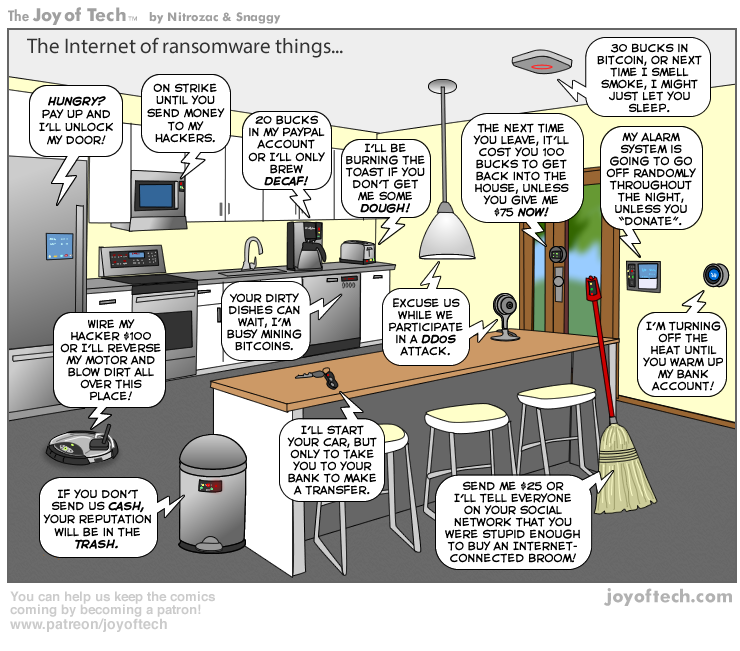Last updated at Thu, 14 Dec 2023 22:22:44 GMT
October is National Cyber Security Awareness month and Rapid7 is taking this time to celebrate security research. This year, NCSAM coincides with new legal protections for security research under the DMCA and the 30th anniversary of the CFAA - a problematic law that hinders beneficial security research. Throughout the month, we will be sharing content that enhances understanding of what independent security research is, how it benefits the digital ecosystem, and the challenges that researchers face.
2016 can be characterized as the year that IoT security research took off, both here at Rapid7 and across the security researcher community. While IoT security research was certainly being conducted in years past, it was contentious within our community as "too easy" or simply "stunt hacking." But as the body of research in this space grows along with the prevalence of IoT, it's become obvious that this sort of "easy" hacking is critical to not only the security of these devices in and of themselves, but to the safety of the people nearby these devices.
After all, the hallmarks of IoT is both the ability to interact with the real, physical space around the devices, and to communicate with other devices. Security failures, therefore, can both directly affect the humans who are relying on them and open attack vectors against nearby devices and the networks they are connected to.
With that in mind, I'd like take a moment to consider the more noteworthy events in IoT Security, and how together, they make the case that this year is when we stopped considering IoT security "junk hacking," and started taking these things seriously.
IoT Security in 2016
In January, Brian Knopf announced that the "I Am the Cavalry" security research advocacy group will be publishing an open, collaboration-driven cybersecurity rating system for IoT devices, in contrast to Underwriter Labs' proprietary standards. This isn't the first announced strategy to comprehensively rate the security of IoT devices, but it's certainly the most open. Transparency is crucial in security research and testing, since it allows for independent verification, reproducibility, and accountability.
In March, researcher Wish Wu of Trend Micro reported a pair of vulnerabilities in a Qualcomm component of the Android operating system which, if exploited, can allow a malicious application to grab root-level permissions. Wu presented these findings and others in May at the Hack in the Box security conference. While these bugs have been patched by Google, these findings remain significant for two reasons. One, Android is rapidly becoming the de facto standard operating system for the Internet of Things -- not just smartphones -- so bugs in Android can have downstream effects in everything from television set-top boxes, to children's toys, to medical devices. Second, and more worrying, many of these devices do not have the capability to get timely security updates or to upgrade their operating systems. Given the lack of moving parts in these machines, they can chug along for years without patches.
In May, researcher Earlance Fernandes and others at the University of Michigan demonstrated several vulnerabilities in Samsung's SmartThings platform for home automation, which centered around abusing and subverting applications to gain privileges, including a remote attack to reset a door lock PIN. Design issues of over-privileged applications are certainly not limited to Samsung's software engineering, but is commonplace in IoT infrastructure. Oftentimes, the services and applications that ship on IoT devices aren't designed with privilege constraints in mind. If the service does what it's supposed to do with administrative / root privileges, there isn't a lot of incentive to design it to work in a less permissive model, especially when designers aren't considering the motives or opportunity of a malicious user. In other words, while most traditional computers have pretty solid user privilege models, IoT devices often ignore this fundamental security concept.
In September, the Michigan Senate Judiciary Committee passed a bill that forbids some forms of "car hacking," but importantly, includes protections for research activities. These exemptions weren't included in the original text of the bill, but thanks to the efforts of Rapid7's Harley Geiger, we've seen a significant change in the way that legislators in Michigan view automotive cyber security and the value of security research there. While this bill is not yet law, the significance of this shift in thinking can't be understated.
Also in September, some of the early fears of widespread IoT-based insecurity manifested in the highly public IoT-powered DDoS attack against journalist Brian Krebs. This attack was made possible, in part, by the massive population of unpatched, unmanaged, and unsecured home routers, a topic explored way back in January by yours truly. Of course, I'm not saying I called it, but... I kinda called it.🙂
Some closing pictures
Who doesn't love a good Google Trends graph? We can see from the below that interest in the "IoT Security" search term has doubled since the beginning of 2016, and I'd be surprised to see it hit any significant decline in the years to come.

While much of this interest is pretty doomy and/or gloomy, it's healthy to be considering IoT security today, and I'm glad that IoT appears to be getting the respect and serious attention it deserves in the security research community. It's only through the efforts of individual, focused security researchers that we'll able to get a handle on the issues that bedevil the IoT-scape. Otherwise, we're looking at a future as envisioned by Joy of Tech:


